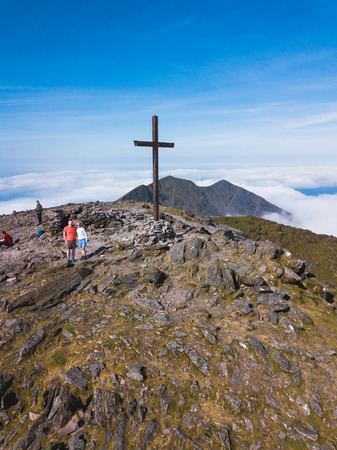Introduction: Tracing the Celtic Pilgrimage Route
The journey from Iona to Lindisfarne stands as one of Britain’s most evocative spiritual odysseys, weaving together centuries of history, devotion, and cultural exchange. At its core, this route traces the movement of early Celtic Christianity across the rugged landscapes of Scotland and northern England, embodying a legacy that transcends mere geography. The pilgrimage commences at Iona, a windswept Hebridean isle renowned as the cradle of Scottish Christianity, where St Columba established a monastic community in AD 563. From these humble beginnings, the faith travelled eastward, crossing not only physical borders but also bridging diverse communities and traditions along its path. The destination, Lindisfarne—often called Holy Island—emerged as a beacon of learning and sanctity on the Northumbrian coast, deeply influencing British spirituality. Today, retracing this route offers pilgrims and travellers alike an opportunity to engage with a unique cross-border heritage, reflecting on themes of unity, resilience, and the enduring quest for spiritual meaning amidst some of Britain’s most dramatic landscapes.
Iona: Birthplace of Celtic Christianity
Situated off the rugged west coast of Scotland, the small island of Iona holds a profound place in the narrative of British Christianity. This remote isle became the cradle of Celtic Christianity when St Columba and his twelve companions landed on its shores in 563 AD, establishing a monastic community that would radiate spiritual and cultural influence far beyond its modest boundaries.
Origins of the Pilgrimage at Iona
The pilgrimage tradition to Iona began almost immediately after its foundation. The monastery served as both a religious centre and a beacon for travellers seeking spiritual renewal. Pilgrims—ranging from local Picts to distant Anglo-Saxon nobles—made arduous journeys to Iona, drawn by its reputation for sanctity and learning.
Ecclesiastical History and Influence
Iona’s monastic community quickly became a hub for ecclesiastical scholarship, manuscript production, and missionary outreach. The monks, under Columba’s leadership, forged vital links with neighbouring communities and played a pivotal role in the conversion of the Pictish and Northumbrian kingdoms. The following table outlines key milestones in Iona’s ecclesiastical history:
| Year | Event | Significance |
|---|---|---|
| 563 AD | St Columba arrives on Iona | Foundation of the first monastery; beginning of Celtic Christian influence |
| 597 AD | Death of St Columba | Iona becomes a site of pilgrimage; consolidation as a spiritual centre |
| 635 AD | Mission to Northumbria (Lindisfarne) | Celtic Christianity spreads into northern England through Lindisfarne priory |
| 8th Century | Viking raids begin | Monastic community endures hardship but continues influencing wider Britain |
Lasting Legacy Across Britain
Iona’s enduring impact is evident in its role as the origin point for subsequent monastic foundations across Britain, notably Lindisfarne. Through these connections, Iona’s distinctive blend of faith, artistry, and learning permeated both Scottish and English religious traditions. Pilgrims today continue to retrace ancient steps, seeking inspiration from the island’s tranquil landscape and storied past—a testament to Iona’s lasting resonance within British spiritual heritage.

3. Traversing the Borders: The Pilgrim’s Path
The journey from Iona to Lindisfarne, often revered as the Celtic Pilgrimage, is not merely a passage across geographical boundaries but also a profound traverse through cultural landscapes that have shaped both Scotland and northern England. This route—steeped in legend and devotion—invites modern-day pilgrims to follow in the footsteps of early Christian saints, bridging ancient kingdoms and communities along its rugged way.
Key Waypoints on the Pilgrim Trail
The path from Iona, off the west coast of Scotland, to Lindisfarne, the Holy Island off Northumberland’s shore, encompasses several significant waypoints. Pilgrims traditionally set out from the tranquil cloisters of Iona Abbey, crossing Mull and the mainland before reaching Whithorn, an early centre of Christianity. From there, journeyers might pass through Glasgow or Edinburgh—cities echoing with both medieval and contemporary life—before traversing the Tweed Valley into Northumbria. Melrose Abbey and Bamburgh Castle are notable stops, each bearing witness to centuries of religious and cultural interchange.
Landscapes Shaped by History and Nature
This pilgrimage is as much an immersion in landscape as it is a spiritual exercise. The terrain shifts dramatically: from the windswept Hebridean shores and peat bogs of Argyll to the rolling hills of the Borders and finally to the tidal flats leading to Lindisfarne itself. Each region tells its own story—the wild beauty of Scottish lochs contrasting with the cultivated farmlands near Berwick-upon-Tweed, all bound together by ancient pathways and stone crosses that mark the route.
An Evolving Pilgrim Experience
While medieval pilgrims braved these paths for penance or devotion, today’s travellers often seek a blend of reflection and reconnection with heritage. Modern amenities coexist with timeless rituals; one might encounter local hospitality at village inns or join small parish communities for prayer along the way. Yet the essence remains unchanged: crossing these borders is an act of unity—between past and present, faith and doubt, land and sea. The enduring appeal of this pilgrimage lies in its ability to foster both personal transformation and shared cultural memory across generations.
4. Encounters Along the Way: Communities and Traditions
The journey from Iona to Lindisfarne is not merely a traverse across geographical boundaries; it is an immersion into the living heart of Celtic heritage, shaped by the communities who have long inhabited these storied lands. Pilgrims find themselves welcomed by villages and towns whose hospitality has become legendary, echoing ancient monastic traditions of sanctuary and fellowship. Each settlement along the route offers a unique window into the enduring customs that have defined regional identity for generations.
Hospitality and Community Spirit
One of the most striking features of this pilgrimage is the open-handed welcome extended by local people. Whether sharing a simple meal, offering directions, or recounting tales of saints and ancestors, these acts of kindness reinforce the interconnectedness between visitor and host. Such hospitality is not incidental but deeply rooted in Celtic Christian values, where welcoming the stranger is considered both a duty and a blessing.
Enduring Traditions and Regional Identity
The route is punctuated by festivals, crafts, and communal gatherings that continue to thrive despite modern pressures. These traditions are central to sustaining a sense of place and belonging, providing pilgrims with opportunities to participate in rituals that date back centuries. From Gaelic singing on Iona to Northumbrian pipe music near Lindisfarne, each practice tells a story of resilience and adaptation.
Key Traditions Encountered Along the Route
| Location | Tradition | Description |
|---|---|---|
| Iona | Gaelic Psalm Singing | Communal singing during worship, reflecting island’s spiritual heritage |
| Mull & Argyll | Celtic Craftsmanship | Hand-carved stone crosses and weaving, preserving ancient skills |
| Scottish Borders | Ceilidh Gatherings | Social events with music, dance, and storytelling fostering community bonds |
| Lindisfarne (Holy Island) | Pilgrimage Crossing Rituals | Processions across tidal causeway symbolising spiritual journey |
The Pilgrimage as a Shaper of Regional Identity
This convergence of hospitality and tradition plays a pivotal role in shaping local identity. The steady stream of pilgrims brings with it a sense of shared purpose, uniting communities across borders through collective memory and spiritual aspiration. In many places, the continued observance of age-old customs serves as both an anchor to the past and a beacon for future generations.
5. Arrival at Lindisfarne: The Holy Island’s Legacy
For countless pilgrims traversing the ancient Celtic routes from Iona, the arrival at Lindisfarne—known affectionately as the Holy Island—marks both a physical and spiritual culmination. Nestled off the rugged coast of Northumberland and accessible only at low tide, Lindisfarne’s evocative landscape is steeped in a unique blend of natural beauty and profound historical resonance.
The Historical Prominence of Lindisfarne
Lindisfarne’s significance is anchored in its early medieval history. Established by St Aidan in AD 635, the island became a beacon of Christian learning and monastic life under the patronage of King Oswald of Northumbria. The Lindisfarne Gospels—an illuminated masterpiece crafted on the island—stand testament to its scholarly influence across Britain and beyond. Furthermore, the infamous Viking raid of 793 catapulted Lindisfarne into European consciousness, symbolising both vulnerability and resilience during a transformative era for the church.
Spiritual Significance for Pilgrims
Lindisfarne has long been revered as a locus of spiritual renewal. For those who journey from Iona, each step echoes the footsteps of Celtic saints, culminating in an encounter with Lindisfarne’s serene priory ruins, ancient crosses, and windswept shores. The rhythm of the tides dictating access to the island mirrors the contemplative ebb and flow central to Celtic spirituality. Many pilgrims report a profound sense of presence here—a connection not just to history but to a living tradition that continues to inspire reflection and transformation.
The Role of Lindisfarne as Pilgrimage Destination
As the terminus of the Celtic pilgrimage, Lindisfarne encapsulates both destination and destiny. It serves as a gathering place for modern seekers, faith groups, and cultural enthusiasts alike. Annual pilgrimages and local festivals celebrate this enduring heritage, bridging ancient practice with contemporary expression. The island remains a testament to reconciliation across borders—spiritual, cultural, and even national—reflecting the wider narrative of unity that defines much of Britain’s early Christian story.
A Living Legacy
Ultimately, Lindisfarne endures not merely as a relic but as a living legacy. Its quiet lanes, resilient community, and open hospitality invite all who arrive to pause and reflect on their own journeys—reminding us that pilgrimage is as much about inner transformation as it is about traversing physical landscapes.
6. Reflections: The Modern Appeal of the Celtic Pilgrimage
Revival Pilgrimages and Renewed Interest
In recent decades, the route from Iona to Lindisfarne has experienced a resurgence in popularity, not only among spiritual seekers but also as a focal point for those interested in British heritage and outdoor adventure. Revival pilgrimages—both organised and independent—have become increasingly common, drawing individuals and groups eager to retrace the footsteps of early Celtic saints. This renewed interest is fuelled by a desire to reconnect with the contemplative traditions of the past, fostering a sense of continuity between ancient and modern expressions of faith.
Pilgrimage Tourism: A Blend of Heritage and Hospitality
The economic and social impact of this revival has been significant for local communities along the route. Villages, churches, and accommodation providers have adapted to welcome pilgrims and tourists alike, offering hospitality that honours both tradition and contemporary needs. From guided walks across dramatic coastal landscapes to quiet moments in centuries-old chapels, pilgrimage tourism on this route offers a uniquely British blend of history, culture, and natural beauty.
Modern Spirituality: Seeking Meaning in Movement
For many contemporary participants, the pilgrimage from Iona to Lindisfarne transcends religious affiliation. It serves as a journey of self-discovery and reflection—a way to step back from the demands of modern life and engage with something greater than oneself. Walking these ancient paths provides space for contemplation, connection with nature, and meaningful encounters with fellow travellers. The physical journey becomes a metaphor for personal growth and transformation, resonating deeply with those seeking spiritual renewal in today’s complex world.
A Continuing Legacy Across Borders
The enduring appeal of the Iona to Lindisfarne pilgrimage lies in its ability to bridge past and present, sacred and secular. As more people undertake this cross-border journey each year—whether out of devotion, curiosity, or a longing for deeper purpose—the route continues to inspire new generations. In doing so, it reaffirms Britain’s rich Celtic heritage while inviting all who walk it to participate in an ongoing story of faith, community, and discovery.

